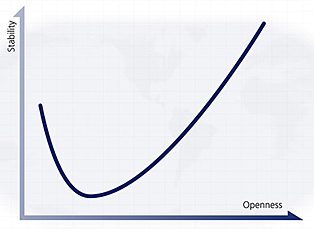The reality of the productivity dip
Perhaps one of the greatest difficulties in change management is the “productivity dip.” It isn’t as scary as it sounds. In fact, it’s nothing more than the typical learning curve or J-curve. What this means is that it’s normal to trend downward before beginning the climb upward when implementing change. Like the letter J, you start at point A—the tail—then travel the downward before soaring to point B—the top.

The J-curve in context
To better illustrate this concept, take Lee Loughnane of the rock group Chicago, a great musician who has been playing the trumpet for over 60 years now. Loughnane knew that his methods of breathing and blowing could not be sustained as his body aged, so he sought out a coach to retrain him how to breathe and blow the horn. He knew that there would be a learning curve, a dip in his playing ability, but he would eventually become a better player with more capacity to continue playing despite his age. Today, he continues to rock the audiences at concerts around the world.
A similar situation exists with computer programs. Many companies implement programs to improve their productivity, but those programs eventually become outdated. Purchasing and learning to use a new program inevitably results in lower productivity for a period of time. The trade off? Substantially higher productivity once training is complete.

All J’s are not the same
It’s important to note that variations in change management affect the J-curve graph substantially. For instance, poor training can create a much deeper and more costly dip while also minimizing the final levels of improvement. Effective training, on the other hand, will minimize the depth and cost of the dip while resulting in significantly higher levels of improvement.

Change management tips to navigate the J-curve with confidence
Moving through the J-curve is never easy, but that doesn’t mean it has to be a bumpy road. Consider these three change management strategies to shorten the ride.
- Anticipate questions and concerns
With any new implementation, it’s always wise to gather a list of frequently asked questions and common issues employees may have regarding the new system and answer them in a meaningful manner. This way, you’ll reduce the likelihood of encountering repetitive questions. Try to answer the 5 W’s if applicable: Who, Where, When, What, Why.
- Keep track of important metrics
It won’t be easy to gauge the success of your implementation if you’re not measuring it. Establish data points and goals that will help you identify which employees or departments need additional support.
- Slow down
Good change management happens over a period of time, not all at once. Every organization wants to overcome the J-curve as quickly as possible, but if rushing to do so doesn’t cause implementation to fail, it will surely reduce its ultimate effectiveness.

Contact ReSource Pro to transform your operations through change management and other strategy .



